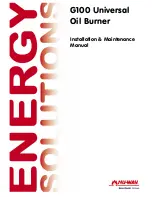
901176-00 NC
8
ihp.us.com
INSTALLATION
Continued
* Purchase the optional equipment shutoff valve from your dealer�
**Minimum inlet pressure for purpose of input adjustment�
Figure B - Gas Connection
Pipe Cap Tee
Nipple Joint
Gas Control
3" Minimum
Sediment Trap
Equipment Shutoff Valve
With 1/8" NPT Tap*
Approved Flexible Gas
Hose (if allowed by
local codes)
NATURAL
From Gas
Meter
(5" W�C�**
to 10�5" W�C�
Pressure)
CAUTION: Avoid damage to gas control. Hold gas
control with wrench when connecting it to gas piping
and/or fittings.
WARNING: Test all gas piping and connections,
internal and external to unit, for leaks after installing
or servicing. Correct all leaks at once.
WARNING: Never use an open flame to check for
a leak. Apply a noncorrosive leak detection fluid to
all joints. Bubbles forming show a leak. Correct all
leaks at once.
Install in piping system between fuel supply and appliance� Locate
sediment trap where trapped matter is not likely to freeze� A sediment
trap traps moisture and contaminants� This keeps them from going
into appliance controls� If sediment trap is not installed or is installed
wrong, appliance may not run properly�
CHECKING GAS CONNECTIONS
PRESSURE TESTING GAS SUPPLY PIPING SYSTEM
The appliance and its appliance main gas valve must be disconnected
from the gas supply piping system during any pressure testing of
that system at test pressures
in excess of
1/2 psi (3�5 kPa)�
The appliance must be isolated from the gas supply piping system
by closing its equipment shutoff valve during any pressure testing of
the gas supply piping system at test pressures
equal to or less than
1/2 psi (3�5 kPa)�
Test Pressures In Excess Of 1/2 PSIG (3.5 kPa)
1� Disconnect appliance with its appliance main gas valve (control
valve) and equipment shutoff valve from gas supply piping system�
Pressures in excess of 1/2 psig will damage appliance regulator�
2� Cap off open end of gas pipe where equipment shutoff valve was
connected�
3� Pressurize supply piping system by opening main gas valve lo-
cated on or near gas meter for natural gas or using compressed
air�
Test Pressures Equal To or Less Than 1/2 PSIG (3.5 kPa)
1� Close equipment shutoff valve
(see
Figure C
).
2� Pressurize supply piping system by opening main gas valve lo-
cated on or near gas meter for natural gas or using compressed
air�
3� Check all joints from gas meter to equipment shutoff valve for
natural gas
.
Apply noncorrosive leak detection fluid to all joints�
Bubbles forming show a leak�
4� Correct all leaks at once�
PRESSURE TESTING APPLIANCE GAS CONNECTIONS
1� Open equipment shutoff valve
(see
Figure C
)
�
2� Open main gas valve located on or near gas meter for natural gas�
3� Make sure control knob of appliance is in the OFF position�
4� Check all joints from gas meter to equipment shutoff valve for
natural gas
.
Apply noncorrosive leak detection fluid to all joints�
Bubbles forming show a leak�
5� Correct all leaks at once�
6� Light appliance
(see Remote Lighting,
Page 11
)
� Check all other
internal joints for leaks�
7� Turn off appliance
(see Shutting Down,
Page 11
).
Figure C
- Equipment Shutoff Valve
Open
Closed
Equipment
Shutoff
Valve
4� Check all joints of gas supply piping system� Apply noncorrosive
leak detection fluid to all joints� Bubbles forming show a leak�
5� Correct all leaks at once�
6� Reconnect appliance and equipment shutoff valve to gas supply�
Check reconnected fittings for leaks�
Figure D
- Checking Gas Joints (Natural Gas Only)
GAS ENTERS EIS FROM GAS
METER
GAS LEAVES EIS
THROUGH FIREPLACE
AND CONNECTS TO
LOGSET
EIS
GAS METER
GAS SHUTOFF VALVE








































